Software Analysis Design and Architecture Report for Vermont Council
VerifiedAdded on 2021/05/31
|11
|1044
|76
Report
AI Summary
This report presents a comprehensive software analysis, design, and architecture for the Vermont Council Social Services, employing object modeling techniques. The paper begins with an abstract summarizing the approach, followed by an introduction that highlights the significance of object-oriented modeling in system design. It outlines both functional and non-functional requirements, categorizing them for clarity. The core of the report focuses on the application of object modeling through various UML diagrams, including use case, sequence, activity, state, and class diagrams, which are crucial for visualizing the system's structure and behavior. The conclusion emphasizes the efficiency of object modeling in simplifying complex system development, particularly in the context of the Vermont Council project, and states that the use of object modeling has streamlined the development process, making it more manageable in terms of effort, time, and resources. Finally, the report includes a bibliography of cited sources.
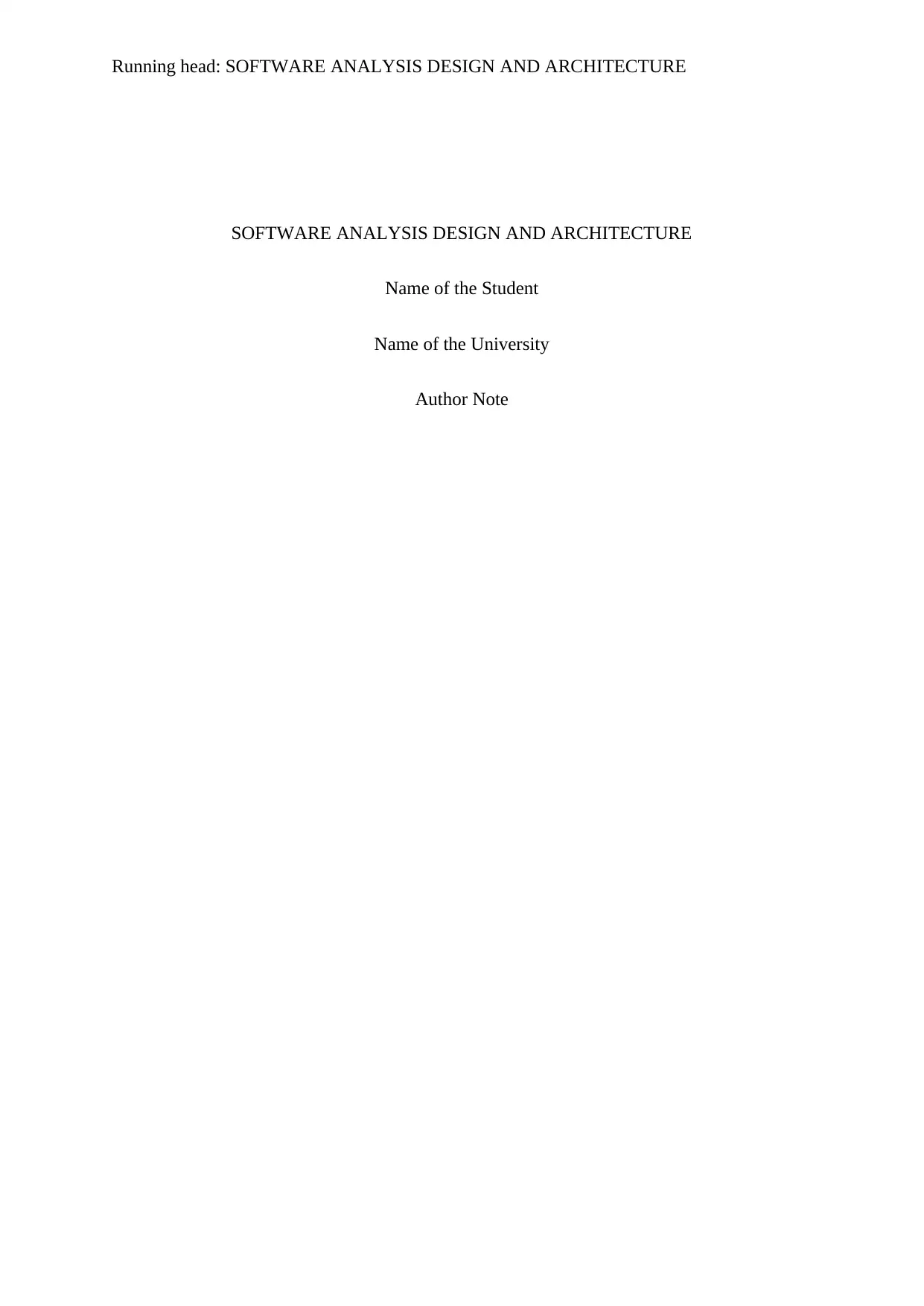
Running head: SOFTWARE ANALYSIS DESIGN AND ARCHITECTURE
SOFTWARE ANALYSIS DESIGN AND ARCHITECTURE
Name of the Student
Name of the University
Author Note
SOFTWARE ANALYSIS DESIGN AND ARCHITECTURE
Name of the Student
Name of the University
Author Note
Paraphrase This Document
Need a fresh take? Get an instant paraphrase of this document with our AI Paraphraser
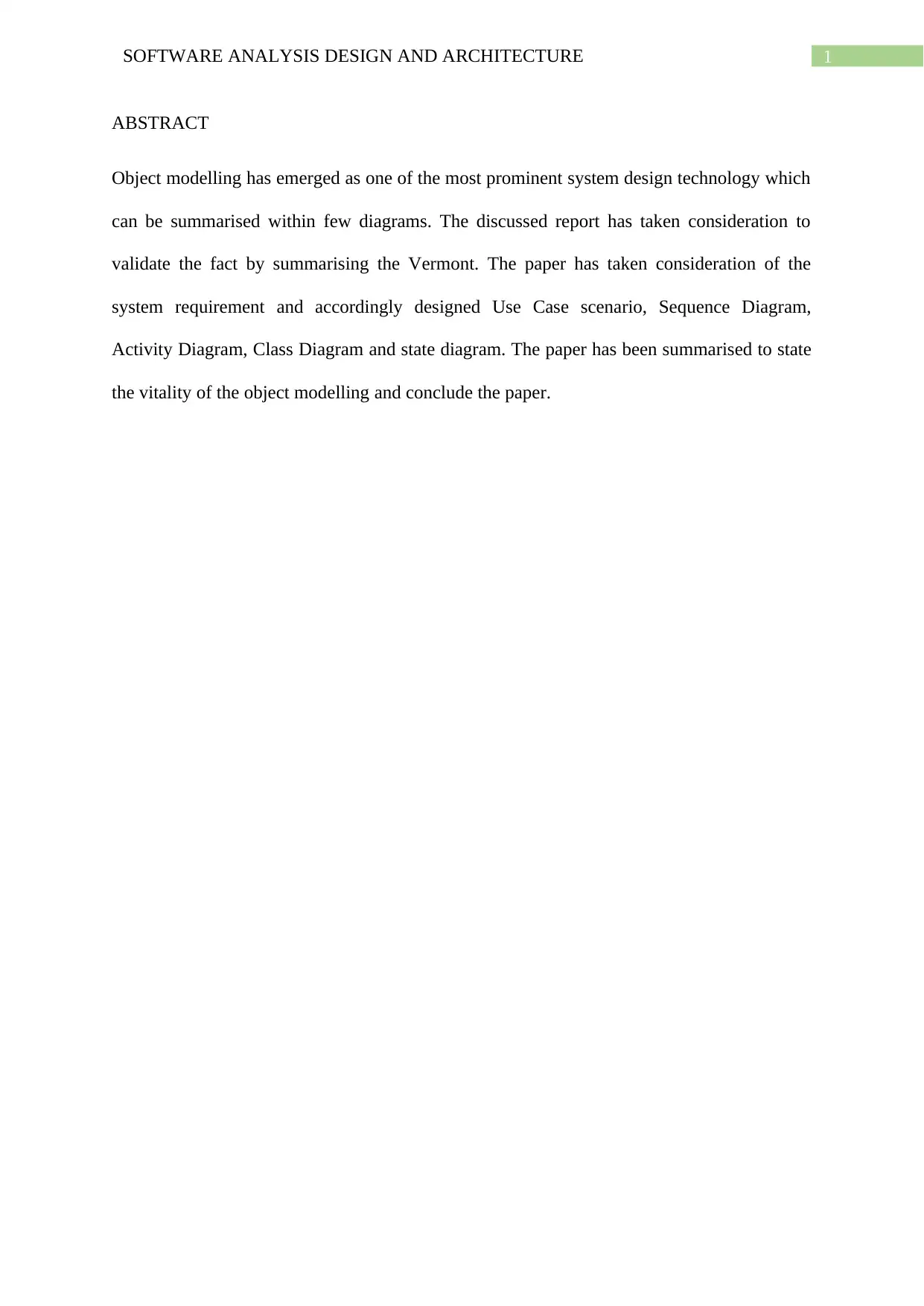
1SOFTWARE ANALYSIS DESIGN AND ARCHITECTURE
ABSTRACT
Object modelling has emerged as one of the most prominent system design technology which
can be summarised within few diagrams. The discussed report has taken consideration to
validate the fact by summarising the Vermont. The paper has taken consideration of the
system requirement and accordingly designed Use Case scenario, Sequence Diagram,
Activity Diagram, Class Diagram and state diagram. The paper has been summarised to state
the vitality of the object modelling and conclude the paper.
ABSTRACT
Object modelling has emerged as one of the most prominent system design technology which
can be summarised within few diagrams. The discussed report has taken consideration to
validate the fact by summarising the Vermont. The paper has taken consideration of the
system requirement and accordingly designed Use Case scenario, Sequence Diagram,
Activity Diagram, Class Diagram and state diagram. The paper has been summarised to state
the vitality of the object modelling and conclude the paper.
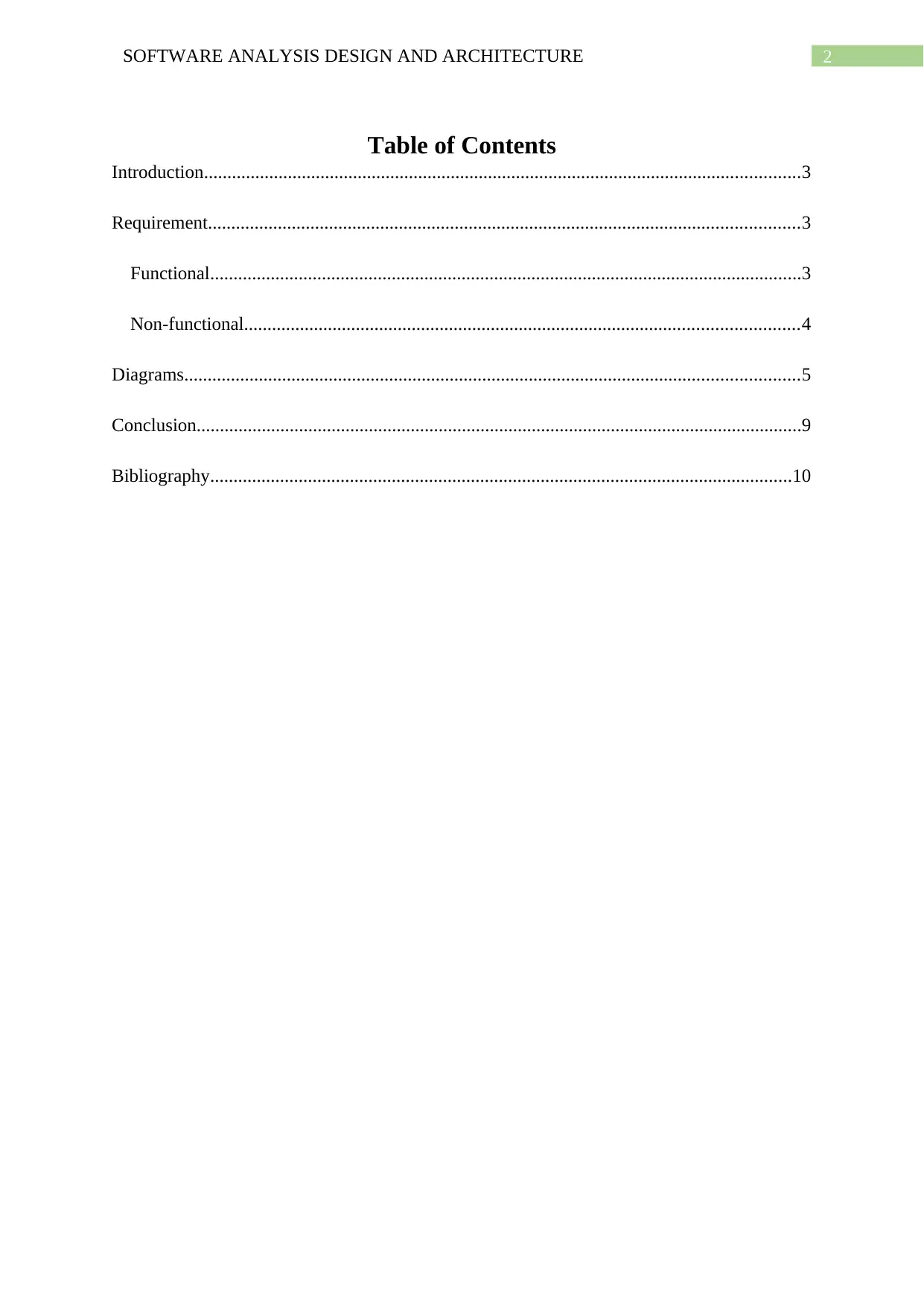
2SOFTWARE ANALYSIS DESIGN AND ARCHITECTURE
Table of Contents
Introduction................................................................................................................................3
Requirement...............................................................................................................................3
Functional...............................................................................................................................3
Non-functional.......................................................................................................................4
Diagrams....................................................................................................................................5
Conclusion..................................................................................................................................9
Bibliography.............................................................................................................................10
Table of Contents
Introduction................................................................................................................................3
Requirement...............................................................................................................................3
Functional...............................................................................................................................3
Non-functional.......................................................................................................................4
Diagrams....................................................................................................................................5
Conclusion..................................................................................................................................9
Bibliography.............................................................................................................................10
⊘ This is a preview!⊘
Do you want full access?
Subscribe today to unlock all pages.

Trusted by 1+ million students worldwide
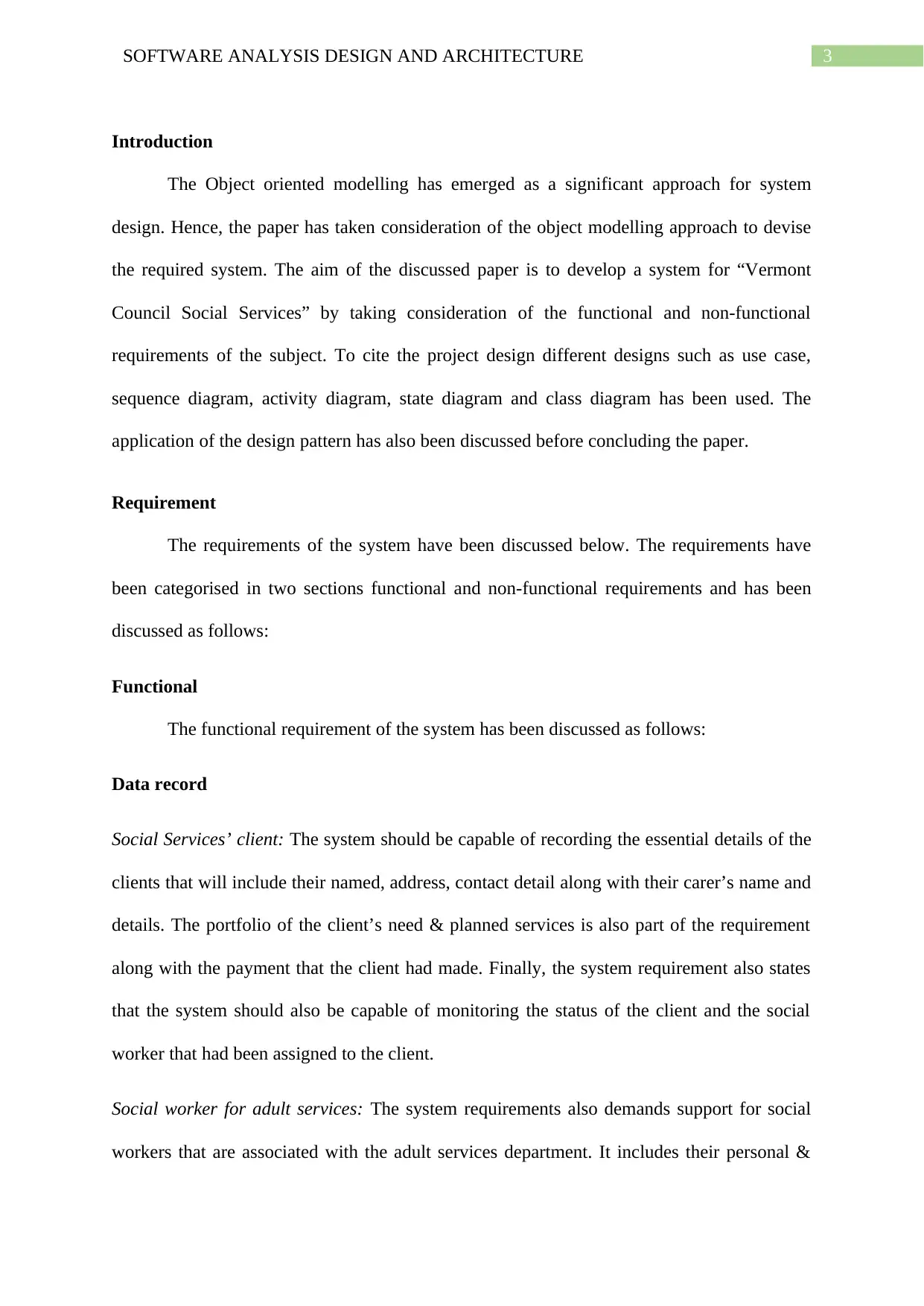
3SOFTWARE ANALYSIS DESIGN AND ARCHITECTURE
Introduction
The Object oriented modelling has emerged as a significant approach for system
design. Hence, the paper has taken consideration of the object modelling approach to devise
the required system. The aim of the discussed paper is to develop a system for “Vermont
Council Social Services” by taking consideration of the functional and non-functional
requirements of the subject. To cite the project design different designs such as use case,
sequence diagram, activity diagram, state diagram and class diagram has been used. The
application of the design pattern has also been discussed before concluding the paper.
Requirement
The requirements of the system have been discussed below. The requirements have
been categorised in two sections functional and non-functional requirements and has been
discussed as follows:
Functional
The functional requirement of the system has been discussed as follows:
Data record
Social Services’ client: The system should be capable of recording the essential details of the
clients that will include their named, address, contact detail along with their carer’s name and
details. The portfolio of the client’s need & planned services is also part of the requirement
along with the payment that the client had made. Finally, the system requirement also states
that the system should also be capable of monitoring the status of the client and the social
worker that had been assigned to the client.
Social worker for adult services: The system requirements also demands support for social
workers that are associated with the adult services department. It includes their personal &
Introduction
The Object oriented modelling has emerged as a significant approach for system
design. Hence, the paper has taken consideration of the object modelling approach to devise
the required system. The aim of the discussed paper is to develop a system for “Vermont
Council Social Services” by taking consideration of the functional and non-functional
requirements of the subject. To cite the project design different designs such as use case,
sequence diagram, activity diagram, state diagram and class diagram has been used. The
application of the design pattern has also been discussed before concluding the paper.
Requirement
The requirements of the system have been discussed below. The requirements have
been categorised in two sections functional and non-functional requirements and has been
discussed as follows:
Functional
The functional requirement of the system has been discussed as follows:
Data record
Social Services’ client: The system should be capable of recording the essential details of the
clients that will include their named, address, contact detail along with their carer’s name and
details. The portfolio of the client’s need & planned services is also part of the requirement
along with the payment that the client had made. Finally, the system requirement also states
that the system should also be capable of monitoring the status of the client and the social
worker that had been assigned to the client.
Social worker for adult services: The system requirements also demands support for social
workers that are associated with the adult services department. It includes their personal &
Paraphrase This Document
Need a fresh take? Get an instant paraphrase of this document with our AI Paraphraser
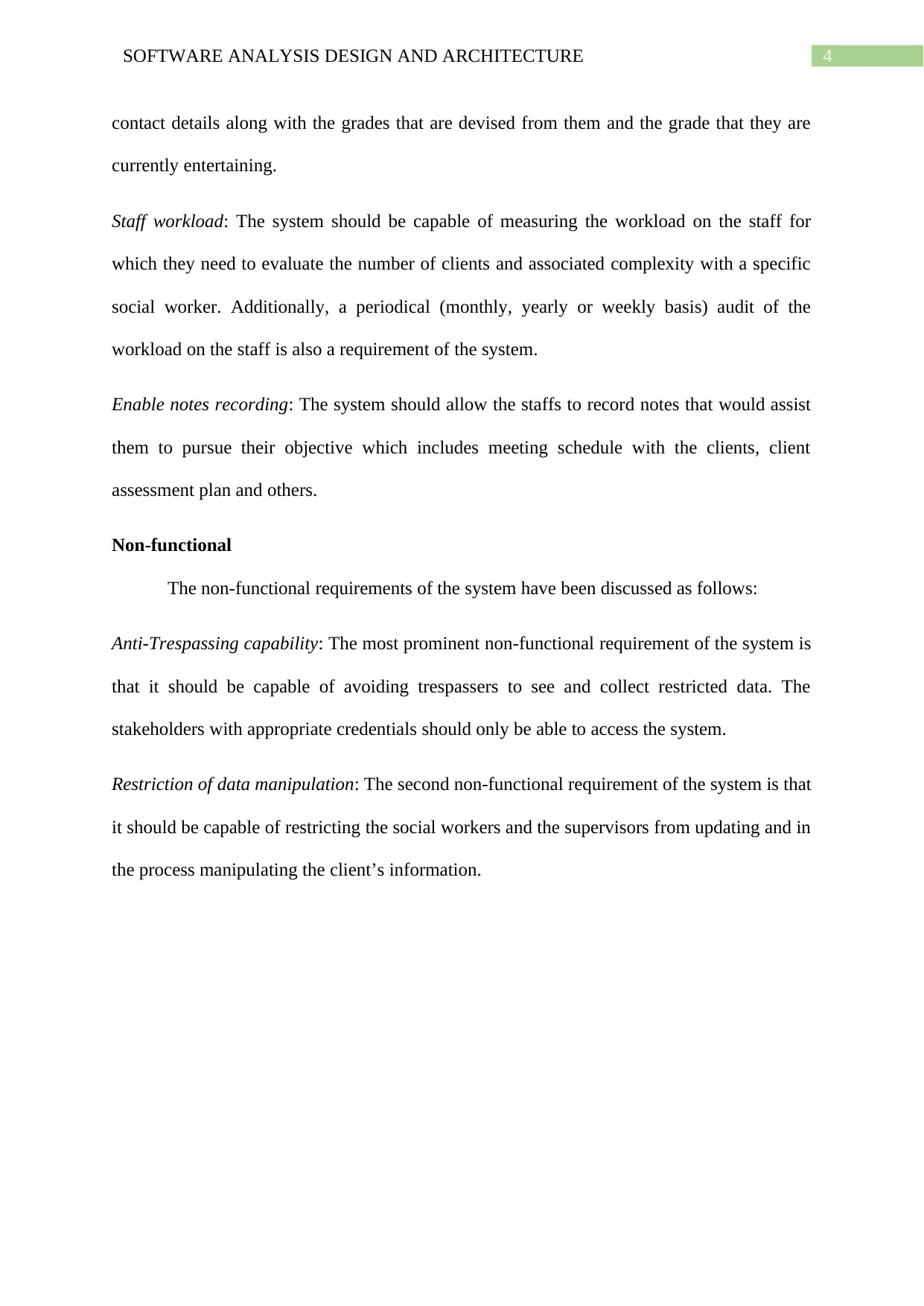
4SOFTWARE ANALYSIS DESIGN AND ARCHITECTURE
contact details along with the grades that are devised from them and the grade that they are
currently entertaining.
Staff workload: The system should be capable of measuring the workload on the staff for
which they need to evaluate the number of clients and associated complexity with a specific
social worker. Additionally, a periodical (monthly, yearly or weekly basis) audit of the
workload on the staff is also a requirement of the system.
Enable notes recording: The system should allow the staffs to record notes that would assist
them to pursue their objective which includes meeting schedule with the clients, client
assessment plan and others.
Non-functional
The non-functional requirements of the system have been discussed as follows:
Anti-Trespassing capability: The most prominent non-functional requirement of the system is
that it should be capable of avoiding trespassers to see and collect restricted data. The
stakeholders with appropriate credentials should only be able to access the system.
Restriction of data manipulation: The second non-functional requirement of the system is that
it should be capable of restricting the social workers and the supervisors from updating and in
the process manipulating the client’s information.
contact details along with the grades that are devised from them and the grade that they are
currently entertaining.
Staff workload: The system should be capable of measuring the workload on the staff for
which they need to evaluate the number of clients and associated complexity with a specific
social worker. Additionally, a periodical (monthly, yearly or weekly basis) audit of the
workload on the staff is also a requirement of the system.
Enable notes recording: The system should allow the staffs to record notes that would assist
them to pursue their objective which includes meeting schedule with the clients, client
assessment plan and others.
Non-functional
The non-functional requirements of the system have been discussed as follows:
Anti-Trespassing capability: The most prominent non-functional requirement of the system is
that it should be capable of avoiding trespassers to see and collect restricted data. The
stakeholders with appropriate credentials should only be able to access the system.
Restriction of data manipulation: The second non-functional requirement of the system is that
it should be capable of restricting the social workers and the supervisors from updating and in
the process manipulating the client’s information.
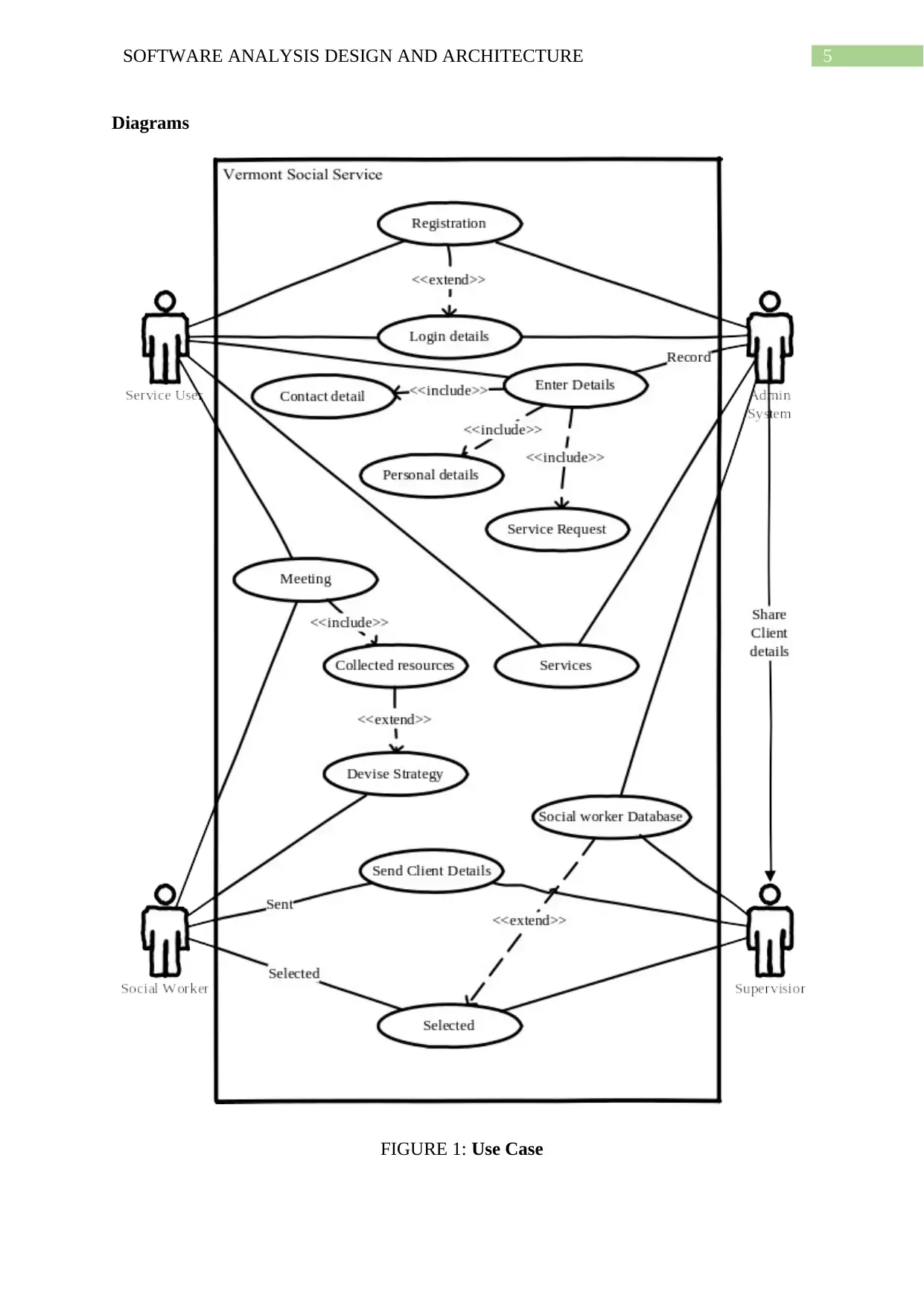
5SOFTWARE ANALYSIS DESIGN AND ARCHITECTURE
Diagrams
FIGURE 1: Use Case
Diagrams
FIGURE 1: Use Case
⊘ This is a preview!⊘
Do you want full access?
Subscribe today to unlock all pages.

Trusted by 1+ million students worldwide
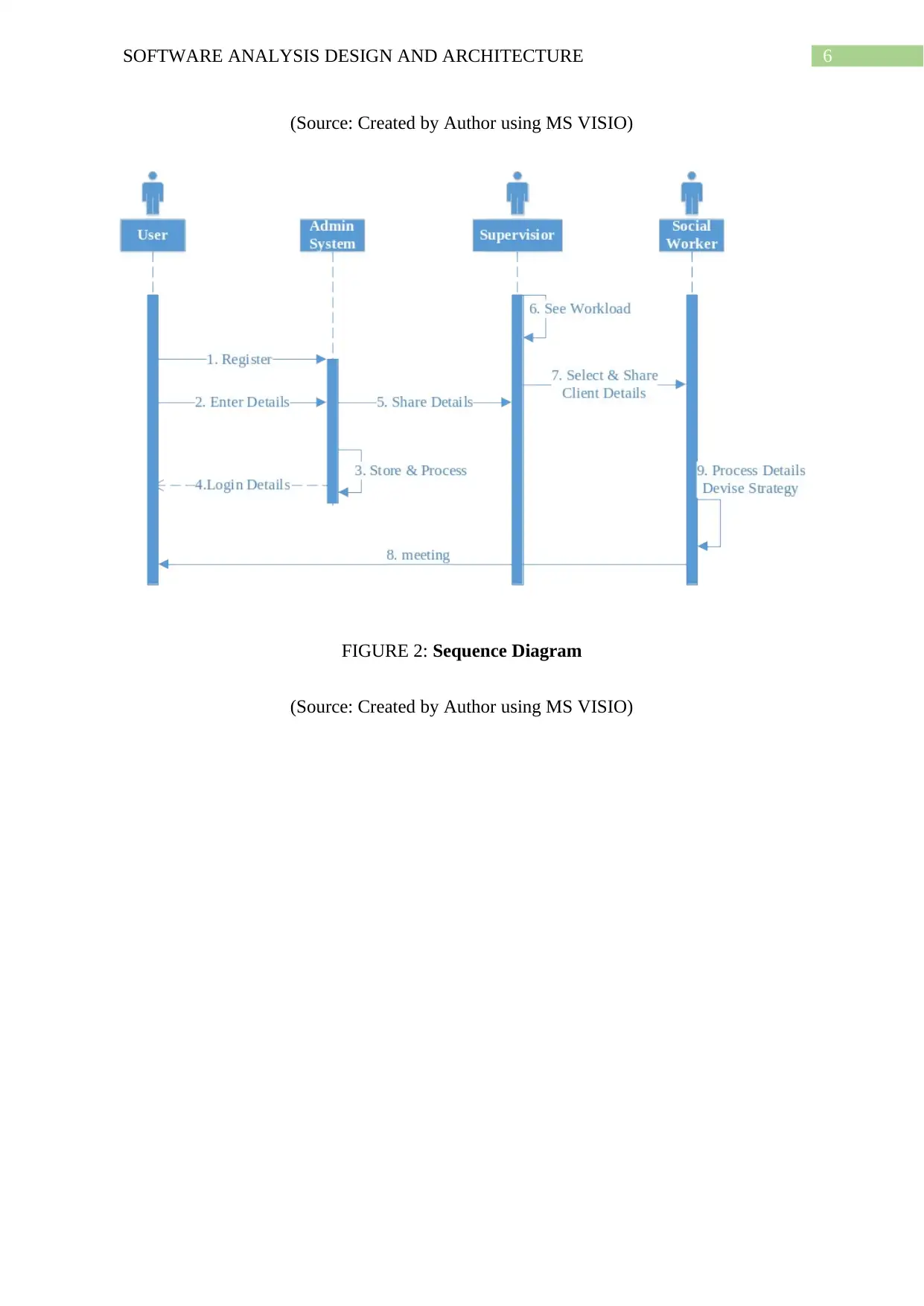
6SOFTWARE ANALYSIS DESIGN AND ARCHITECTURE
(Source: Created by Author using MS VISIO)
FIGURE 2: Sequence Diagram
(Source: Created by Author using MS VISIO)
(Source: Created by Author using MS VISIO)
FIGURE 2: Sequence Diagram
(Source: Created by Author using MS VISIO)
Paraphrase This Document
Need a fresh take? Get an instant paraphrase of this document with our AI Paraphraser
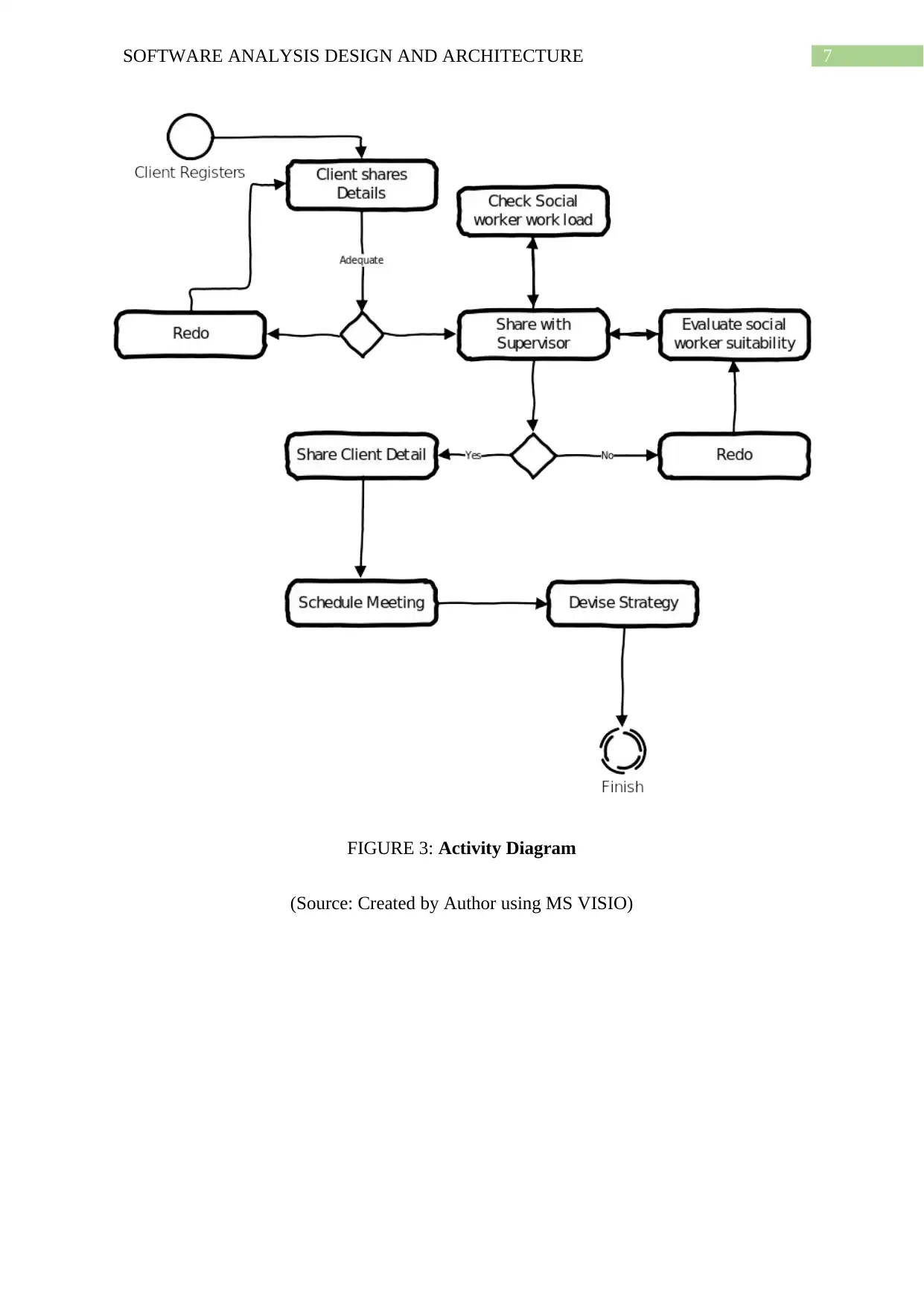
7SOFTWARE ANALYSIS DESIGN AND ARCHITECTURE
FIGURE 3: Activity Diagram
(Source: Created by Author using MS VISIO)
FIGURE 3: Activity Diagram
(Source: Created by Author using MS VISIO)
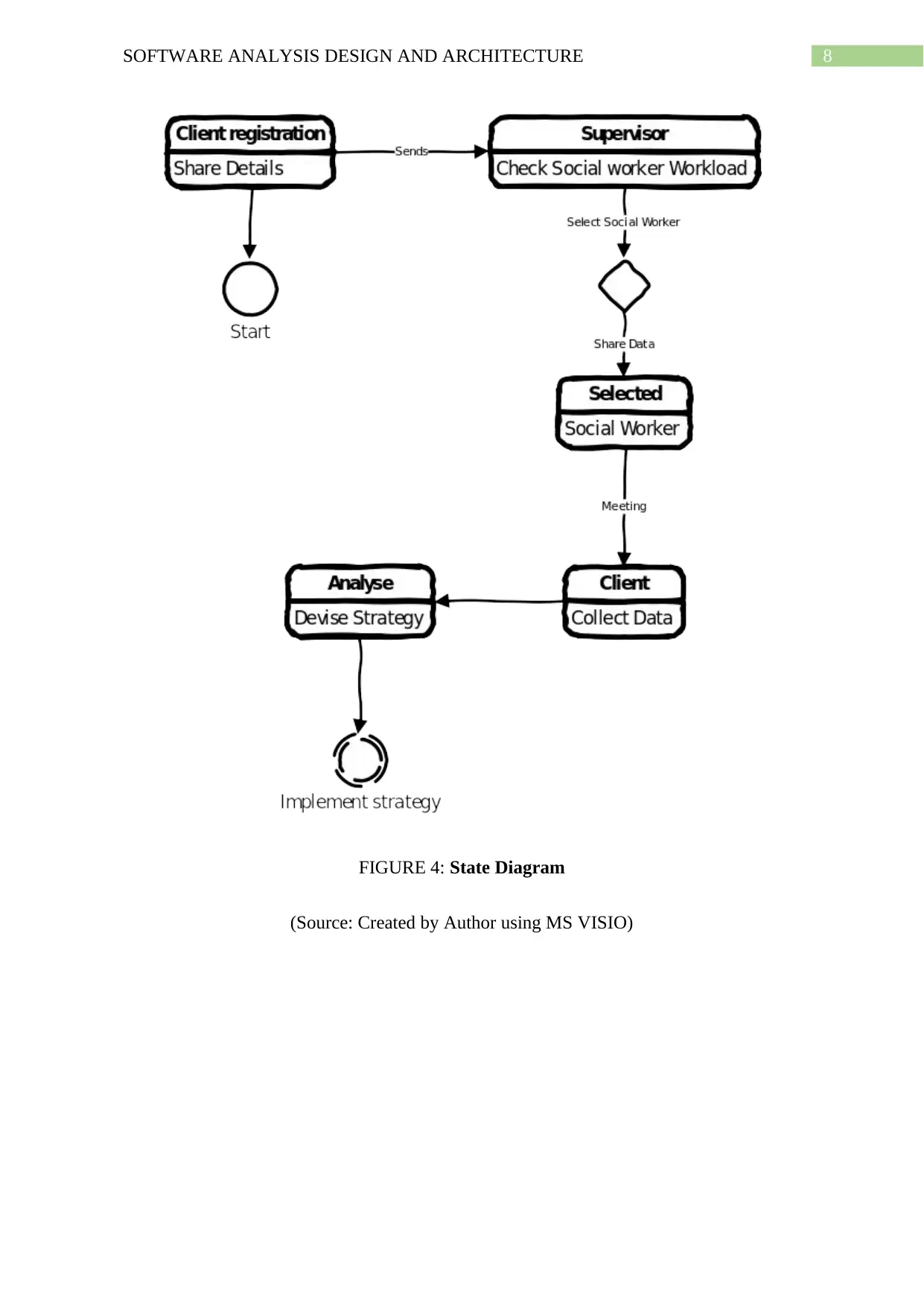
8SOFTWARE ANALYSIS DESIGN AND ARCHITECTURE
FIGURE 4: State Diagram
(Source: Created by Author using MS VISIO)
FIGURE 4: State Diagram
(Source: Created by Author using MS VISIO)
⊘ This is a preview!⊘
Do you want full access?
Subscribe today to unlock all pages.

Trusted by 1+ million students worldwide
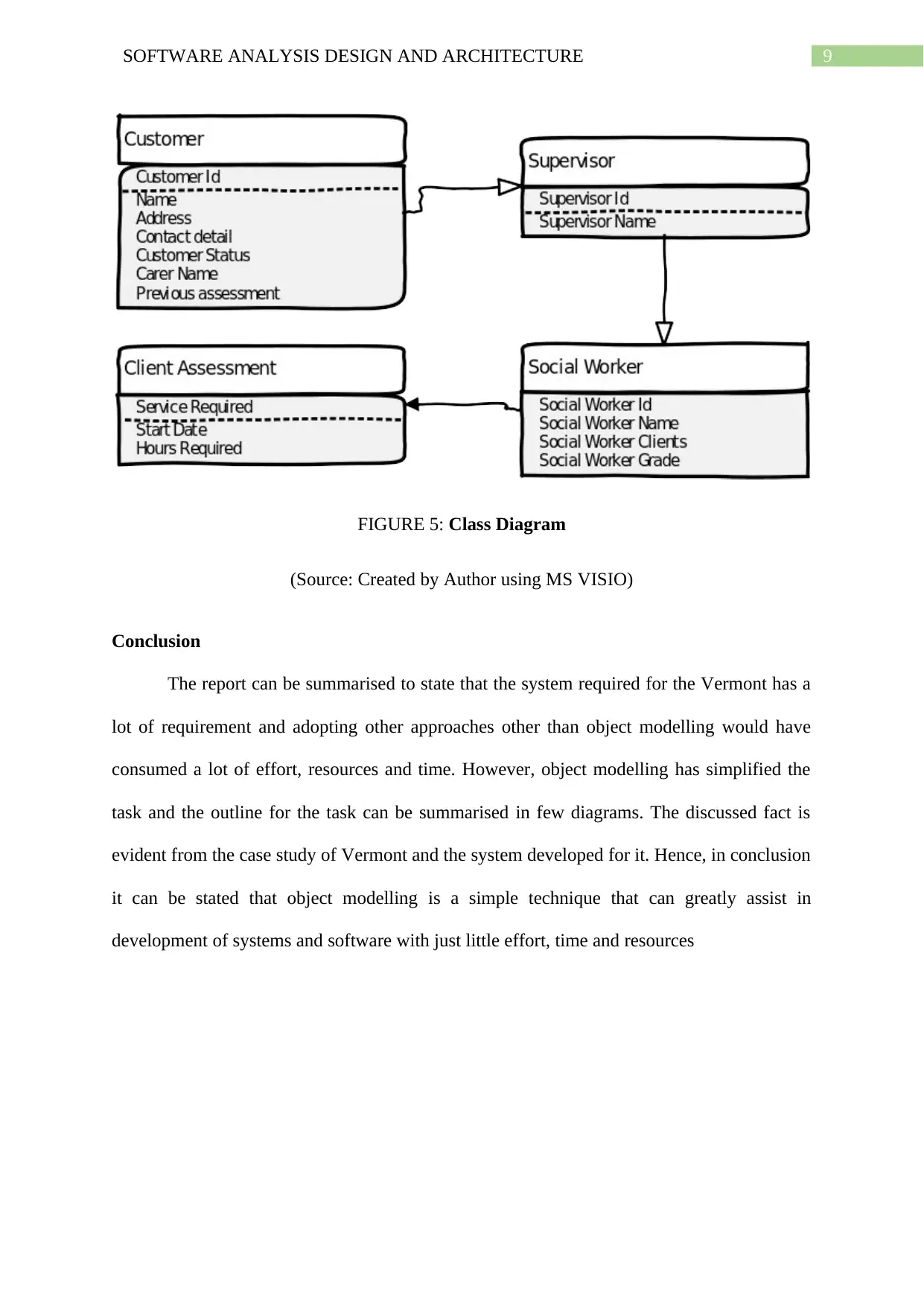
9SOFTWARE ANALYSIS DESIGN AND ARCHITECTURE
FIGURE 5: Class Diagram
(Source: Created by Author using MS VISIO)
Conclusion
The report can be summarised to state that the system required for the Vermont has a
lot of requirement and adopting other approaches other than object modelling would have
consumed a lot of effort, resources and time. However, object modelling has simplified the
task and the outline for the task can be summarised in few diagrams. The discussed fact is
evident from the case study of Vermont and the system developed for it. Hence, in conclusion
it can be stated that object modelling is a simple technique that can greatly assist in
development of systems and software with just little effort, time and resources
FIGURE 5: Class Diagram
(Source: Created by Author using MS VISIO)
Conclusion
The report can be summarised to state that the system required for the Vermont has a
lot of requirement and adopting other approaches other than object modelling would have
consumed a lot of effort, resources and time. However, object modelling has simplified the
task and the outline for the task can be summarised in few diagrams. The discussed fact is
evident from the case study of Vermont and the system developed for it. Hence, in conclusion
it can be stated that object modelling is a simple technique that can greatly assist in
development of systems and software with just little effort, time and resources
Paraphrase This Document
Need a fresh take? Get an instant paraphrase of this document with our AI Paraphraser
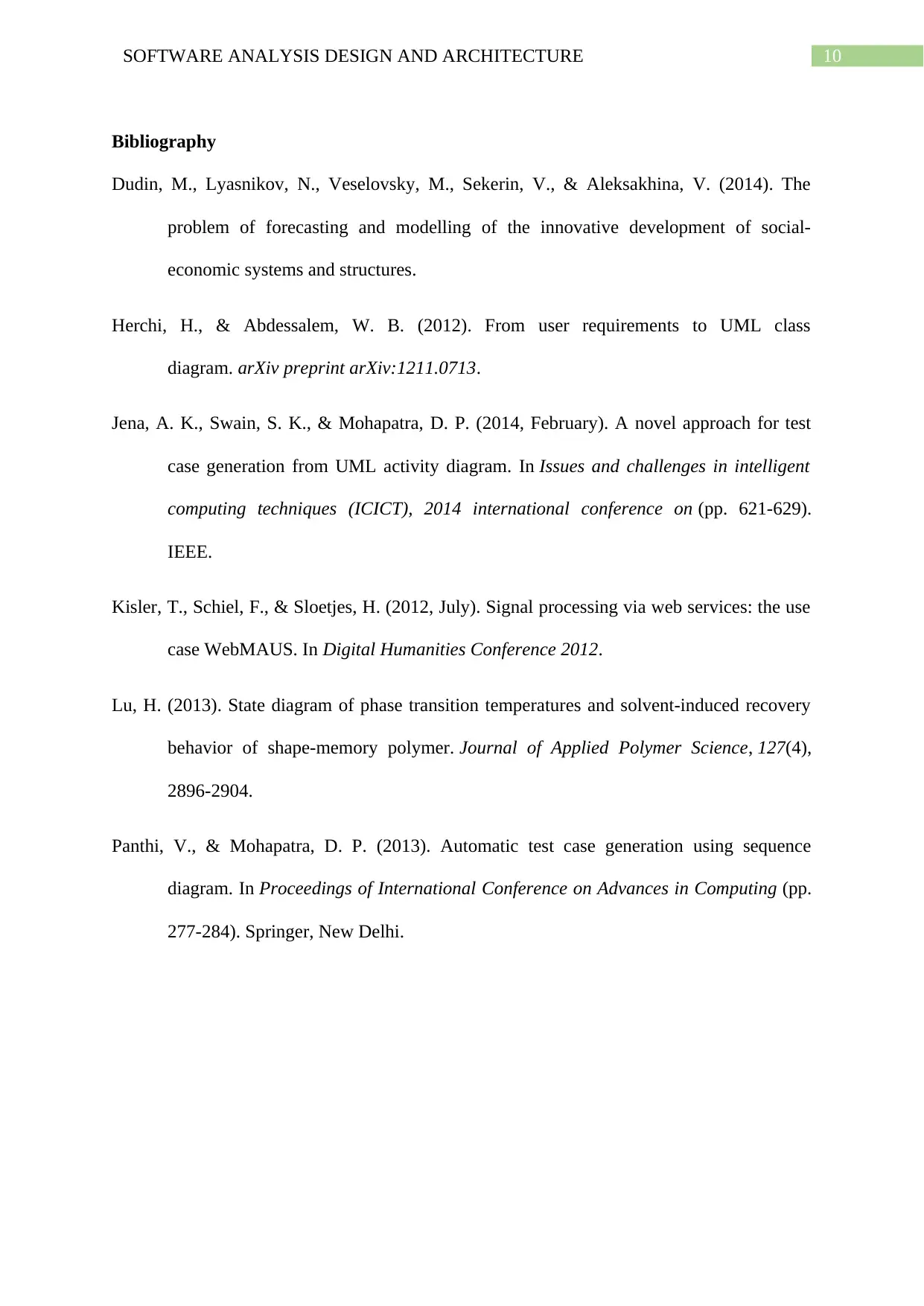
10SOFTWARE ANALYSIS DESIGN AND ARCHITECTURE
Bibliography
Dudin, M., Lyasnikov, N., Veselovsky, M., Sekerin, V., & Aleksakhina, V. (2014). The
problem of forecasting and modelling of the innovative development of social-
economic systems and structures.
Herchi, H., & Abdessalem, W. B. (2012). From user requirements to UML class
diagram. arXiv preprint arXiv:1211.0713.
Jena, A. K., Swain, S. K., & Mohapatra, D. P. (2014, February). A novel approach for test
case generation from UML activity diagram. In Issues and challenges in intelligent
computing techniques (ICICT), 2014 international conference on (pp. 621-629).
IEEE.
Kisler, T., Schiel, F., & Sloetjes, H. (2012, July). Signal processing via web services: the use
case WebMAUS. In Digital Humanities Conference 2012.
Lu, H. (2013). State diagram of phase transition temperatures and solvent‐induced recovery
behavior of shape‐memory polymer. Journal of Applied Polymer Science, 127(4),
2896-2904.
Panthi, V., & Mohapatra, D. P. (2013). Automatic test case generation using sequence
diagram. In Proceedings of International Conference on Advances in Computing (pp.
277-284). Springer, New Delhi.
Bibliography
Dudin, M., Lyasnikov, N., Veselovsky, M., Sekerin, V., & Aleksakhina, V. (2014). The
problem of forecasting and modelling of the innovative development of social-
economic systems and structures.
Herchi, H., & Abdessalem, W. B. (2012). From user requirements to UML class
diagram. arXiv preprint arXiv:1211.0713.
Jena, A. K., Swain, S. K., & Mohapatra, D. P. (2014, February). A novel approach for test
case generation from UML activity diagram. In Issues and challenges in intelligent
computing techniques (ICICT), 2014 international conference on (pp. 621-629).
IEEE.
Kisler, T., Schiel, F., & Sloetjes, H. (2012, July). Signal processing via web services: the use
case WebMAUS. In Digital Humanities Conference 2012.
Lu, H. (2013). State diagram of phase transition temperatures and solvent‐induced recovery
behavior of shape‐memory polymer. Journal of Applied Polymer Science, 127(4),
2896-2904.
Panthi, V., & Mohapatra, D. P. (2013). Automatic test case generation using sequence
diagram. In Proceedings of International Conference on Advances in Computing (pp.
277-284). Springer, New Delhi.
1 out of 11
Related Documents
Your All-in-One AI-Powered Toolkit for Academic Success.
+13062052269
info@desklib.com
Available 24*7 on WhatsApp / Email
![[object Object]](/_next/static/media/star-bottom.7253800d.svg)
Unlock your academic potential
Copyright © 2020–2025 A2Z Services. All Rights Reserved. Developed and managed by ZUCOL.





